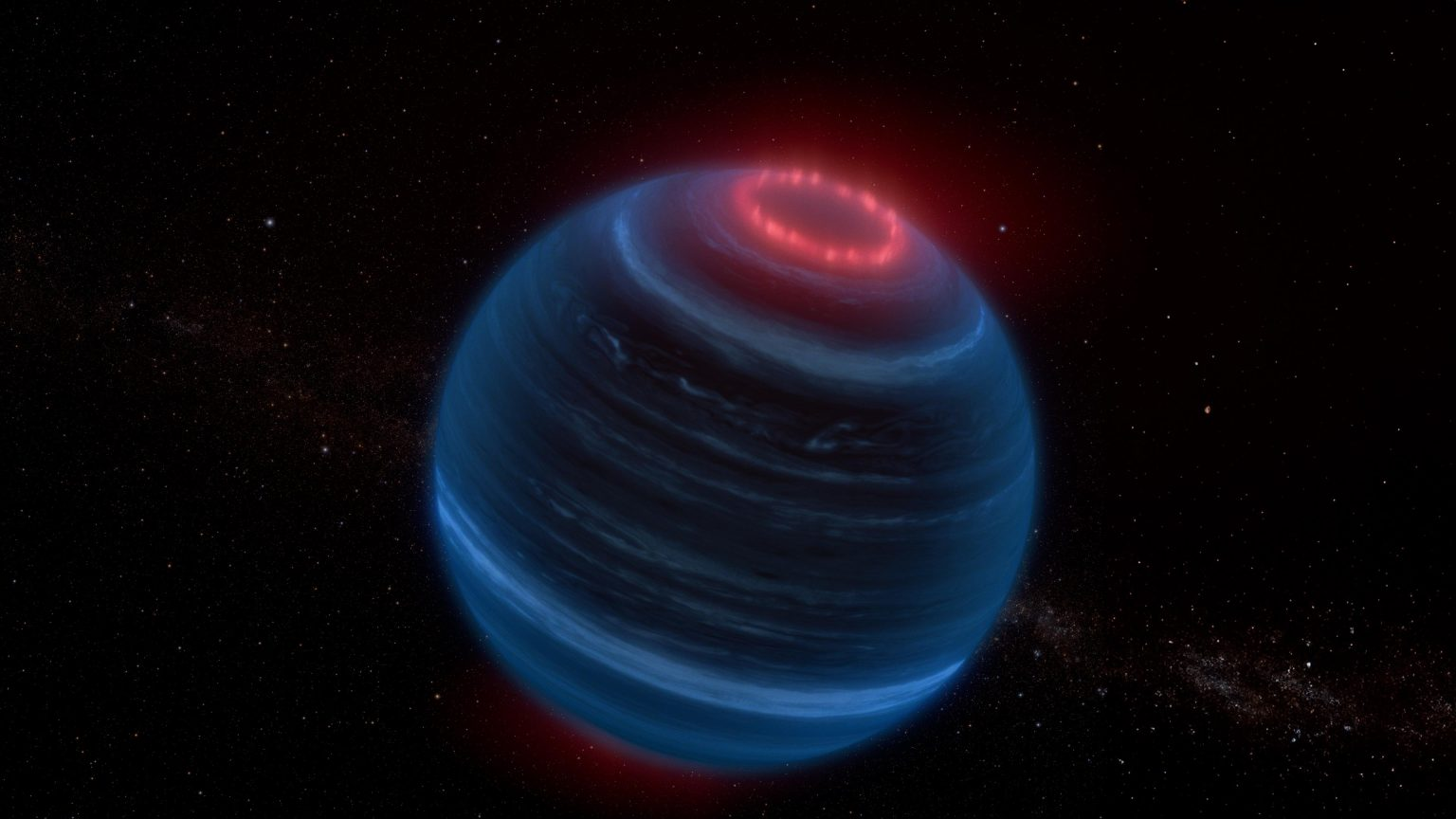"This artist’s concept portrays the brown dwarf W1935, which is located 47 light-years from Earth. Astronomers using NASA’s James Webb Space Telescope found infrared emission from methane coming from W1935. This is an unexpected discovery because the brown dwarf is cold and lacks a host star; therefore, there is no obvious source of energy to heat its upper atmosphere and make the methane glow. The team speculates that the methane emission may be due to processes generating aurorae, shown here in red. Credit: NASA, ESA, CSA, Leah Hustak (STScI), Edited" (ScitechDaily.com/Webb Telescope’s Startling Find: Auroral Phenomenon on a Starless Brown Dwarf)
Infrared Emission From Methane Suggests Atmospheric Heating by Auroral Processes
Astronomers using NASA’s James Webb Space Telescope have found a brown dwarf (an object more massive than Jupiter but smaller than a star) that may display possible aurorae, like the familiar Northern Lights on our world. This is an unexpected mystery because the brown dwarf, known as W1935, is an isolated object in space, with no nearby star to create an aurora.
Aurorae on Earth are made when energetic particles from the Sun are captured by our planet’s magnetic field. Those particles cascade down into our atmosphere near Earth’s poles, colliding with gas molecules and creating eerie, dancing curtains of light. Since W1935 has no star to generate a stellar wind, it’s possible that external interactions with either interstellar plasma or a nearby active moon (like Jupiter’s Io) may help account for the observed infrared emission.(ScitechDaily.com/Webb Telescope’s Startling Find: Auroral Phenomenon on a Starless Brown Dwarf)
"Astronomers used NASA’s James Webb Space Telescope to study 12 cold brown dwarfs. Two of them – W1935 and W2220 – appeared to be near twins of each other in composition, brightness, and temperature. However, W1935 showed emission from methane, as opposed to the anticipated absorption feature that was observed toward W2220. The team speculates that the methane emission may be due to processes generating aurorae. Credit: NASA, ESA, CSA, Leah Hustak (STScI) (ScitechDaily.com/Webb Telescope’s Startling Find: Auroral Phenomenon on a Starless Brown Dwarf)
Brown dwarf W1935 is a so-called failed star. There are no exoplanets around that object. And that lonely stranger has no host star. That means the W1935 offers a good source for the JWST telescope to collect data about brown dwarfs. The brown dwarf is not a star or either planet. Sometimes some brown dwarfs have nuclear fusion periods.
Those periods last a very short time. And during them, the brown dwarf shines its light. When a brown dwarf is in its active period. That thing delivers material into space. A brown dwarf is always lighter after those eruptions. That means periods between brown dwarf's active sessions turn longer. And there is a model that at least some of the brown dwarfs get their energy from fission.
This model goes like this. There is fission material in the brown dwarf's nucleus. The nucleus of those objects would be similar to Earth's nucleus. There are radioactive elements that keep the core in melted form. Then there is fusion material in the atmosphere of the brown dwarfs. When fusion reaction ends gravity pulls the atmosphere to the core.
Then temperature and pressure are high enough that fusion starts again. During that process, the brown dwarf loses its mass.
The brown dwarf is a failed star. The reason for failure is simple. The fusion reaction starts too early in some protostars. If the fusion reaction starts too early and there is not enough material in the protostars. The fusion reaction destroys the protostar or blows lots of material away from it. If the mass of the protostar is too low when fusion starts gravity cannot keep the structure in its form.
In some models, the brown dwarfs form when the planet's remnant travels in interstellar space. Maybe those planets formed around short-living blue stars. And then those stars explode as supernovas.
Inside every gas giant is a small solid core. The supernova blast strips gas off from gas giants like Jupiter and Saturn. And there is a small remnant that remains of the gas giant. If the star is very short-living there could be lots of radioactive material remaining in that planet's core that starts to travel in interstellar space.
There that planet remnant pulls gas and dust to its atmosphere. The gas and dust start to press against the core. The fusion reaction starts and forms a structure. That looks like a hollow ball.
While that process energy impact travels inside the core and jumps back. The energy impact forms a shockwave That destroys the fusion structure and pushes lots of gas out from the brown dwarf.





No comments:
Post a Comment
Note: Only a member of this blog may post a comment.